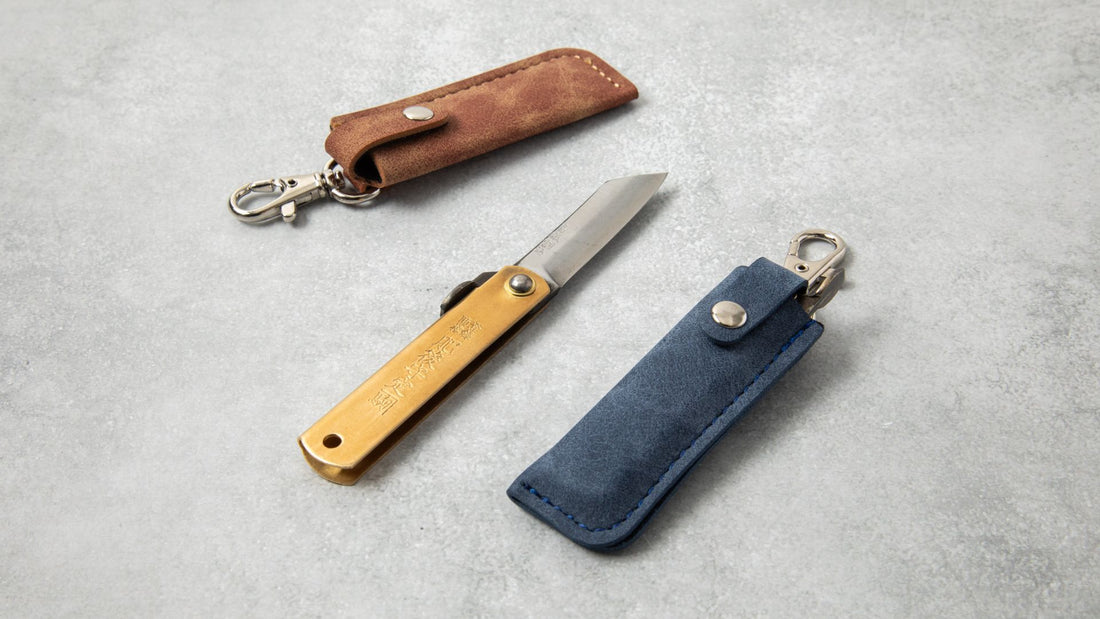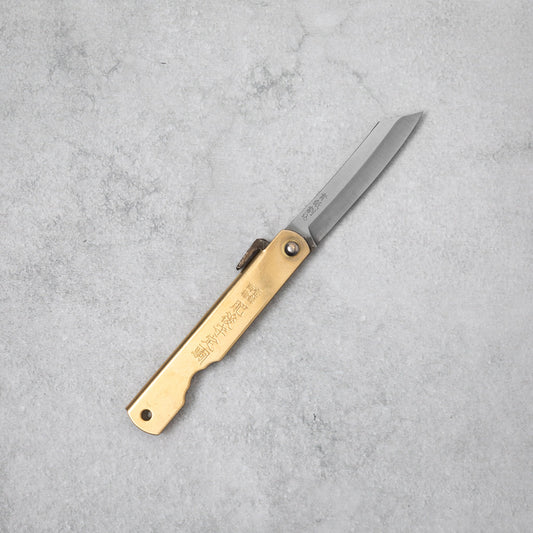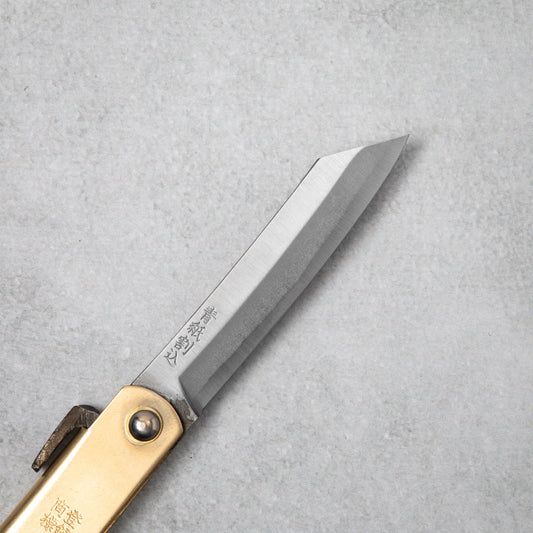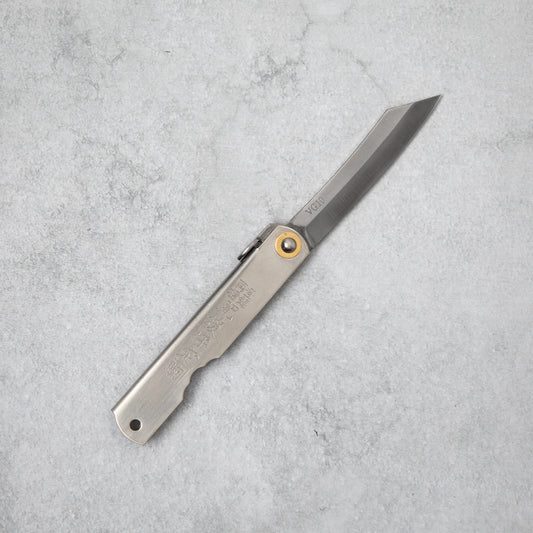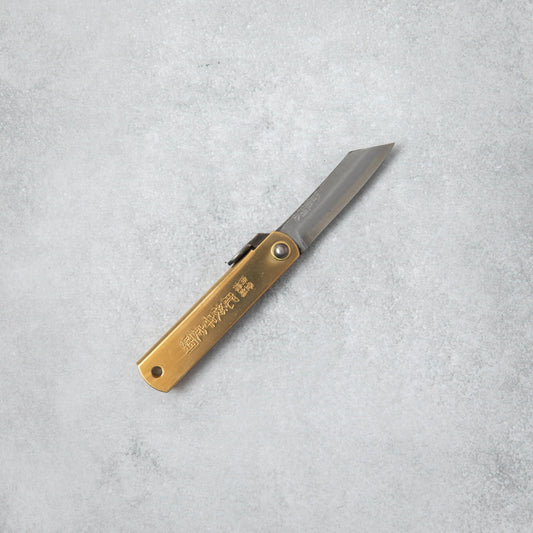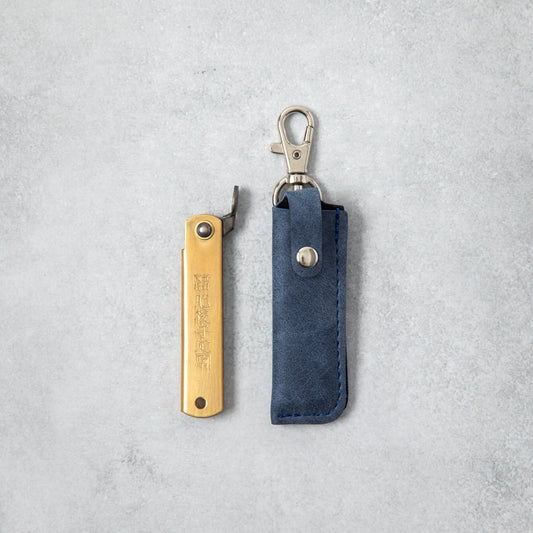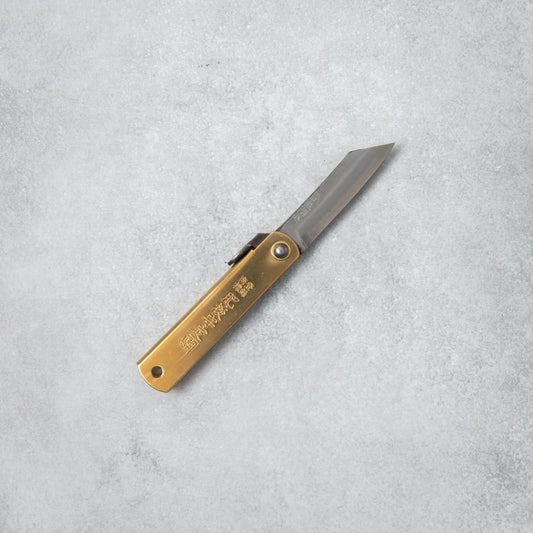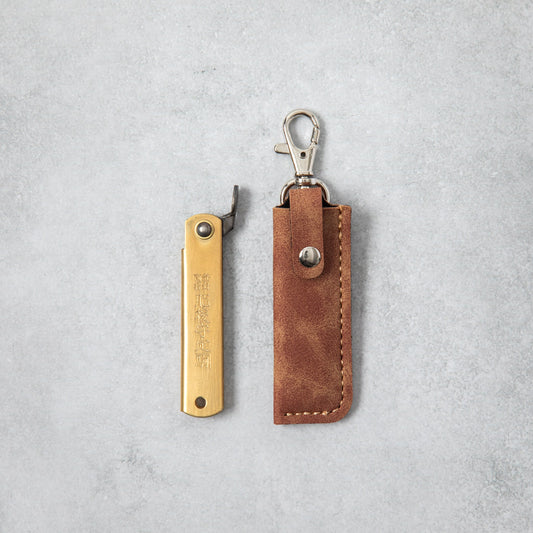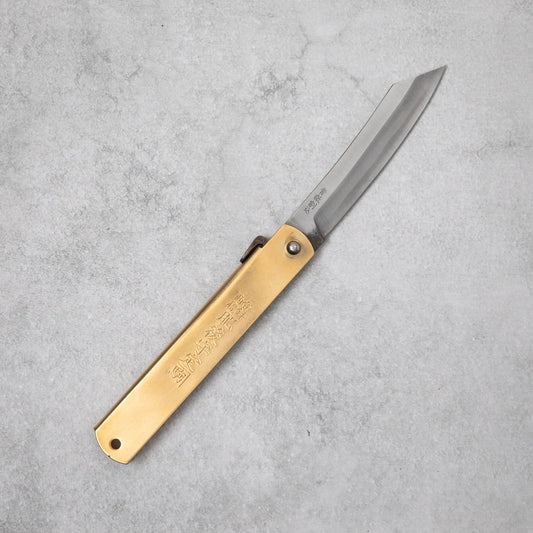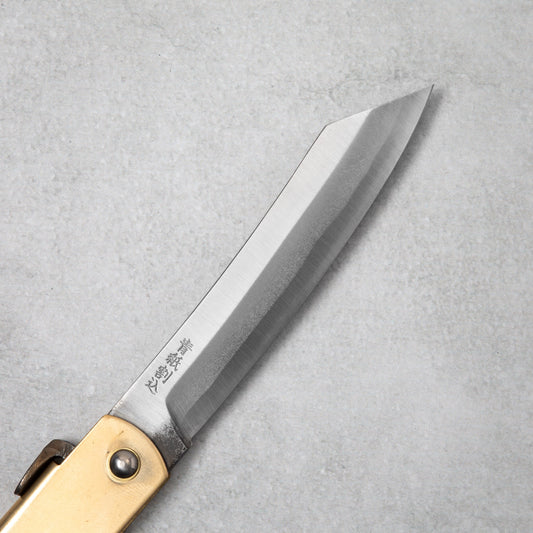While the iconic image of a samurai wielding a katana is firmly etched in our minds, the history of pocket knives in Japan tells a fascinatingly different story. Unlike the elaborate folding knives prized in Western cultures, Japan's pocket knife tradition revolves around a simpler tool: the Higonokami. This humble companion, born in the mid-1800s, offers a unique glimpse into the lives of ordinary Japanese people and the evolution of everyday tools in the face of shifting times.
In this article, we’ll guide you through the history of this useful item. From where it came from, its golden era, to where the Higonokami knives are today.
Contents
- Features of a Higonokami Pocket Knife
- Pocket-sized Introduction
- Blades Before Pockets (Pre-Modern Era)
- The Rise of The Higonokami Knife
- The Post-War Shift and Rise of Pocket Knives (Modern Era)
- Higonokami Today
- In Conclusion
Features of a Higonokami Pocket Knife
Before we get into the history of these pocket blades, here are some key features that make the Higonokami stand out and remain iconic compared to other pocket knives.
- Folding Blade for Compactness: Perhaps the most defining characteristic of the Higonokami is its ingenious folding mechanism. The blade, crafted from high-carbon steel, seamlessly retracts into the handle, transforming the knife into a discreet and eminently portable companion.
- The Chikiri Thumb Lever: Instead of a conventional locking mechanism, the Higonokami employs a clever element known as the "chikiri." This meticulously crafted thumb lever fulfills a dual purpose, effortlessly deploying the blade for use and securing it firmly in its sheath when not required.
- High-carbon Steel Blades: The heart of the Higonokami lies in its exceptional blade, typically forged from high-carbon steel. Renowned for its remarkable sharpness and ability to retain an edge, this steel ensures the knife tackles everyday tasks with unwavering precision.
- Wood or Metal Handles: The Higonokami knife usually comes with a handle made of either wood or metal. Wooden handles are commonly crafted from Japanese Magnolia or Ho wood. Metal Handles are typically made of Brass.
- Elegant, yet Simple Design: The Higonokami's design philosophy celebrates functionality above embellishments. Clean lines and a minimalist aesthetic define its form, resulting in an elegance that transcends fleeting trends.
- Handforged and Crafted: Even in the modern era, the Higonokami remains true to its artisanal roots. Skilled artisans meticulously handcraft each knife using time-honored methods, imbuing each piece with a unique character and a touch of the human spirit.
- Lightweight: Despite its robust build quality, the Higonokami is surprisingly lightweight. This featherweight design translates to effortless maneuverability and comfortable carry, ensuring it remains readily accessible for any task.
- No Locking Mechanism: The Higonokami does not have a locking mechanism; instead, the chikiri is utilized to keep the blade open or closed.
Pocket-sized Introduction

For centuries, the pocket knife has been a ubiquitous companion across the globe. From the elegant folding knives carried by European nobility to the sturdy blades used by American frontiersmen, these compact tools have served many purposes. Pocket knives have been essential for everything from whittling wood and preparing food to self-defense and even fashion statements. Their portability and functionality have made them a cherished item for explorers, worksman, and everyday people alike.
While the West embraced the folding knife with intricate mechanisms and decorative embellishments, Japan's path took a distinct turn. Here, the spotlight falls on the Higonokami, a simple yet enduring pocket knife that emerged in the mid-19th century. Unlike its Western counterparts, the Higonokami prioritizes practicality over ornate design. This no-frills knife, typically featuring a high-carbon steel blade and brass fittings, embodies the Japanese tradition of valuing functionality and minimalism. The Higonokami's story sheds light on the unique way Japanese culture approached the concept of the pocket knife, highlighting a preference for a utilitarian tool that seamlessly integrated into daily life.
Blades Before Pockets (Pre-Modern Era)

In the pre-modern era of Japan, the concept of a pocket knife wasn't a prominent feature in the lives of its citizens. The warrior class, the samurai, dominated society, and their weaponry reflected their societal role. The katana, a curved, single-edged sword, stood as the symbolic weapon of the samurai, revered for its elegance and lethality. These blades, meticulously crafted from high-quality steel, were not just tools of war but symbols of social status and martial prowess. Alongside the katana, the tantō, a shorter dagger, served as a secondary weapon or utility knife for close-quarters combat. The dominance of these iconic blades in Japanese society highlights the emphasis placed on warfare and the samurai code during this period.
Beyond the Battlefield: The Start of Utility Blades

While the katana and tantō held sway in the realm of samurai weaponry, glimpses of smaller utility knives do exist in pre-modern Japan. These knives, often referred to as kogatana (small katana), likely served a variety of purposes in daily life. They might have been used for tasks such as food preparation, whittling wood, or simple repairs. However, unlike the specialized pocket knives found in Western cultures, these tools weren't designed to be carried in a pocket for constant access. They were likely stored in toolkits or tucked into sashes for specific tasks.
The Absence of a Dedicated Pocket Knife

The pre-modern era of Japan, therefore, lacked a dedicated pocket knife concept as prevalent in other parts of the world. The focus on samurai culture and their distinct weaponry overshadowed the need for a small, all-purpose cutting tool. Additionally, the societal structure and daily lives of common people likely revolved less around tasks that demanded a readily available pocket knife. This absence sets the stage for Japan's unique path in the creation of pocket knives, paving the way for the rise of the Higonokami in the centuries to come.
The Rise of The Higonokami

The mid-1800s witnessed the birth of the iconic Higonokami knife in the Miki region of Japan. This pocket knife, deeply rooted in Japanese craftsmanship, boasts a fascinating history that intertwines practicality with artistic heritage. Early Higonokami were meticulously crafted by hand in Hyogo, a region renowned for its metalworking tradition. These exquisite pieces served as testaments to skilled artisanship. Blades, forged from a combination of steel and iron, were housed in beautifully decorated sheaths of brass or black-dyed iron. The sheaths themselves were often adorned with intricate carvings depicting landscapes, figures, or nature, reflecting the artistic flair of the makers. The production process was slow and deliberate, with a single craftsman typically making only a handful of sets per day.
The Higonokami's Rise to Popularity

A turning point arrived in 1894, marking a significant shift in the Higonokami's design philosophy. Originating in Miki, within the Hyogo prefecture, the knife was invented by the skilled blacksmith Iwasaki Kanekichi, who envisioned a more practical and affordable design for everyday use. His creation was inspired by the traditional "Higo-zukuri" knife, a trusted tool utilized by farmers and craftsmen in the region for centuries. This new iteration featured a folding blade and sheath operated by a small lever on the blade itself. He named it after a former province, now Kumamoto prefecture, where many of his customers resided - a decision that proved instrumental in its success. This knife, later known as the Higonokami, gained immense popularity throughout Japan, especially after the Taisho Emperor purchased one himself. The design evolved, with blade shapes transitioning from a sharper tip to a square shape, and sheath styles changing from the vertical folding style to the more common cross folding style.
Functionality Over Frills: The Higonokami's Enduring Legacy

The Higonokami's enduring legacy lies in its emphasis on functionality over ornate embellishments. This pocket knife, typically featuring a high-carbon steel blade and brass fittings, prioritized practicality for everyday tasks. Used for everything from food preparation to sharpening pencils, the Higonokami became a ubiquitous tool for people across Japan. One of its most unique features is the lack of a locking mechanism. The friction of the swivel or pressure of the user's thumb on the iconic lever, known as a chikiri, keeps the blade secure during use. However, the industry faced challenges in later years, including competition from mass-produced utility knives and social campaigns discouraging knife ownership. This resulted in a decline in manufacturers, with only the Nagao family, led by Mitsuo Nagao, continuing to produce genuine Higonokami knives using the original trademark. Today, Nagao Kanekoma Factory stands as the sole custodian of this cherished craft, ensuring the legacy of the Higonokami lives on for generations to come.
The Post-War Shift and Rise of Pocket Knives

The aftermath of World War II ushered in a period of significant change for Japan, including its relationship with bladed weapons. Stricter sword control laws were implemented, leading to a decline in the ownership and use of traditional swords like katanas and tantō. This legislative shift, however, inadvertently paved the way for a rise in the popularity of pocket knives. For many citizens, the pocket knife emerged as a more practical and legal alternative to the previously ubiquitous swords. This newfound popularity presented an opportunity for both domestic and international knife manufacturers.
Embracing the West: The Introduction of Foreign Designs

With the growing demand for pocket knives, Japan witnessed an influx of Western-style folding knives. These knives, often featuring locking mechanisms, multiple blades, and a wider variety of blade shapes and materials, offered a different user experience compared to the traditional Higonokami. Their popularity can be attributed to a combination of factors, including novelty, perceived functionality, and potentially, a subconscious association with the Allied forces. This influx of Western designs presented both competition and inspiration for Japanese knifemakers, who began incorporating some of these elements into their own creations.
A Changing World: The Decline of the Higonokami

The Higonokami, while initially enjoying a resurgence following WWII due to sword control laws, ultimately faced its own challenges. The rise of mass-produced, affordable knives from other countries put pressure on the traditionally crafted Higonokami (mass-produced knives vs Higonokami). Additionally, changing lifestyles in Japan, with a growing focus on urban living and office work, lessened the need for a utilitarian everyday knife. The Higonokami's lack of a locking mechanism, a feature increasingly common in Western-style knives, may have also contributed to its decline in popularity. While the Higonokami remains a cherished symbol of Japanese craftsmanship and continues to be produced by a single family, its dominance in the pocket knife landscape of Japan has shifted significantly in the post-war era.
Higonokami Today

The story of the Higonokami doesn't end with its decline in the post-war era. In recent years, there's been a renewed interest in traditional Japanese knives, with the Higonokami experiencing a resurgence in popularity. This renewed appreciation stems from a desire to connect with Japan's rich history of craftsmanship and a growing recognition of the Higonokami's unique qualities. The simple design and high-quality materials used in its construction resonate with those seeking a timeless and functional tool. The legacy of the Nagao family, the sole remaining producers of genuine Higonokami knives, further adds to the allure of this iconic blade.
Modern Interpretations: Blending Past and Present

The evolution of pocket knives in Japan extends beyond the Higonokami. A new generation of Japanese knifemakers is creating high-quality folding knives that seamlessly blend traditional elements with modern design. These knives often incorporate high-performance steels, innovative locking mechanisms, and ergonomic handle designs, resulting in tools that are both beautiful and practical. They may feature intricate patterns on the blades or artistic flourishes on the handles, drawing inspiration from the decorative aspects of earlier Higonokami designs. This fusion of tradition and innovation ensures that Japanese knifemaking continues to thrive in the 21st century.
In Conclusion
The history of pocket knives in Japan is a fascinating journey that highlights the interplay between tradition, practicality, and cultural shifts. Unlike the West's focus on elaborate folding knives, Japan's path led to the creation of the Higonokami, a simple yet enduring symbol of everyday functionality. While the Higonokami's dominance may have waned, its legacy continues to inspire modern knifemakers and serves as a reminder of the enduring value of Japanese craftsmanship. Whether you hold a meticulously crafted Higonokami or a modern Japanese folding knife, you're not just holding a tool, but a piece of this rich and evolving tradition.


